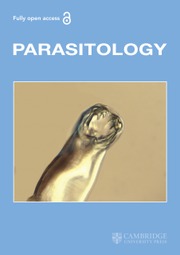Crossref Citations
This article has been cited by the following publications. This list is generated based on data provided by
Crossref.
Lucius, R.
and
Bilger, B.
1995.
Echinococcus multicolularis in Germany: Increased awareness or spreading of a parasite?.
Parasitology Today,
Vol. 11,
Issue. 11,
p.
430.
Craig, P.S.
Rogan, M.T.
and
Allan, J.C.
1996.
Advances in Parasitology Volume 38.
Vol. 38,
Issue. ,
p.
169.
Monnier, Ph.
Cliquet, F.
Aubert, M.
and
Bretagne, S.
1996.
Improvement of a polymerase chain reaction assay for the detection of Echinococcus multilocularis DNA in faecal samples of foxes.
Veterinary Parasitology,
Vol. 67,
Issue. 3-4,
p.
185.
Mathis, A.
Deplazes, P.
and
Eckert, J.
1996.
An improved test system for PCR-based specific detection ofEchinococcus multiloculariseggs.
Journal of Helminthology,
Vol. 70,
Issue. 3,
p.
219.
Schelling, U.
Frank, W.
Will, R.
Romig, T.
and
Lucius, R.
1997.
Chemotherapy with praziquantel has the potential to reduce the prevalence of Echinococcus multilocularis in wild foxes (Vulpes vulpes).
Annals of Tropical Medicine & Parasitology,
Vol. 91,
Issue. 2,
p.
179.
Dinkel, Anke
von Nickisch-Rosenegk, Markus
Bilger, Birgit
Merli, Michael
Lucius, Richard
and
Romig, Thomas
1998.
Detection of
Echinococcus multilocularis
in the Definitive Host: Coprodiagnosis by PCR as an Alternative to Necropsy
.
Journal of Clinical Microbiology,
Vol. 36,
Issue. 7,
p.
1871.
Saitoh, Takashi
and
Takahashi, Kenichi
1998.
The role of vole populations in prevalence of the parasite (Echinococcus multilocularis) in foxes.
Population Ecology,
Vol. 40,
Issue. 1,
p.
97.
Romig, T.
and
Bilger, B.
1999.
Handbook of Animal Models of Infection.
p.
877.
Morishima, Yasuyuki
Tsukada, Hideharu
Nonaka, Nariaki
Oku, Yuzaburo
and
Kamiya, Masao
1999.
Coproantigen survey for Echinococcus multilocularis prevalence of red foxes in Hokkaido, Japan.
Parasitology International,
Vol. 48,
Issue. 2,
p.
121.
van der Giessen, J.W.B
Rombout, Y.B
Franchimont, J.H
Limper, L.P
and
Homan, W.L
1999.
Detection of Echinococcus multilocularis in foxes in The Netherlands.
Veterinary Parasitology,
Vol. 82,
Issue. 1,
p.
49.
Petavy, A.F.
Tenora, F.
Deblock, S.
and
Sergent, V.
2000.
Echinococcus multilocularis in domestic cats in France.
Veterinary Parasitology,
Vol. 87,
Issue. 2-3,
p.
151.
Zhou, H. X.
Chai, S. X.
Craig, P. S.
Delattre, P.
Quéré, J. P.
Raoul, F.
Vuitton, D. A.
Wen, H.
and
Giraudoux, P.
2000.
Epidemiology of alveolar echinococcosis in Xinjiang Uygur autonomous region, China: a preliminary analysis.
Annals of Tropical Medicine & Parasitology,
Vol. 94,
Issue. 7,
p.
715.
Martínek, K.
Kolárová, L.
and
Cervený, J.
2001.
Echinococcus multilocularis in carnivores from the Klatovy district of the Czech Republic.
Journal of Helminthology,
Vol. 75,
Issue. 1,
p.
61.
Manfredi, M. T.
Genchi, C.
Deplazes, P.
Trevisiol, K.
and
Fraquelli, C.
2002.
Echinococcus muftilocularis infection in red foxes in Italy.
Veterinary Record,
Vol. 150,
Issue. 24,
p.
757.
2003.
Zoonoses.
p.
261.
DANSON, F. M.
GRAHAM, A. J.
PLEYDELL, D. R. J.
CAMPOS-PONCE, M.
GIRAUDOUX, P.
and
CRAIG, P. S.
2003.
Multi-scale spatial analysis of human alveolar echinococcosis risk in China.
Parasitology,
Vol. 127,
Issue. S1,
p.
S133.
Hansen, Frank
Tackmann, Kirsten
Jeltsch, Florian
Wissel, Christian
and
Thulke, Hans-Hermann
2003.
Controlling Echinococcus multilocularis—ecological implications of field trials.
Preventive Veterinary Medicine,
Vol. 60,
Issue. 1,
p.
91.
Hegglin, Daniel
Ward, Paul I.
and
Deplazes, Peter
2003.
Anthelmintic Baiting of Foxes against Urban Contamination withEchinococcus multilocularis.
Emerging Infectious Diseases,
Vol. 9,
Issue. 10,
p.
1266.
GIRAUDOUX, P.
CRAIG, P. S.
DELATTRE, P.
BAO, G.
BARTHOLOMOT, B.
HARRAGA, S.
QUÉRÉ, J.-P.
RAOUL, F.
WANG, Y.
SHI, D.
and
VUITTON, D.-A.
2003.
Interactions between landscape changes and host communities can regulateEchinococcus multilocularistransmission.
Parasitology,
Vol. 127,
Issue. S1,
p.
S121.
Sánchez Thevenet, P.
Jensen, O.
Mellado, I.
Torrecillas, C.
Raso, S.
Flores, M.E.
Minvielle, M.C.
and
Basualdo, J.A.
2003.
Presence and persistence of intestinal parasites in canine fecal material collected from the environment in the Province of Chubut, Argentine Patagonia.
Veterinary Parasitology,
Vol. 117,
Issue. 4,
p.
263.


